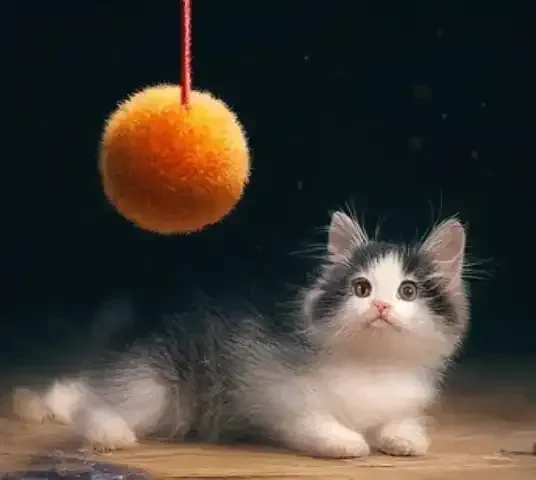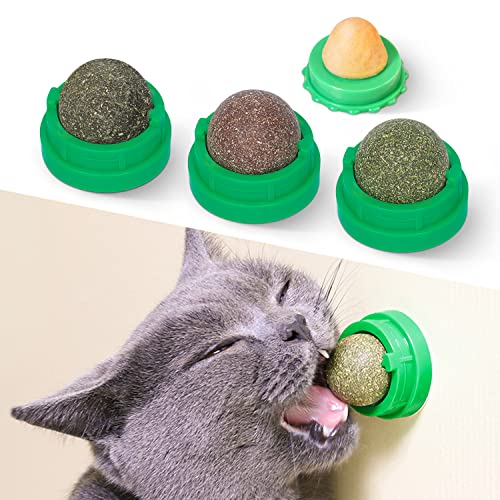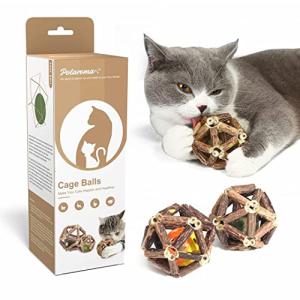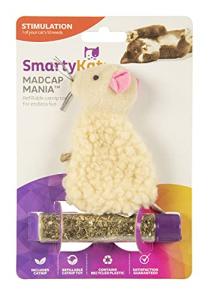Are you watching your feline friend gaze longingly out the window, seemingly indifferent to the mountain of toys gathering dust in the corner? Perhaps playtime has become a less-than-enthusiastic affair, marked more by your energetic attempts to engage than genuine feline interest. If you find yourself in this familiar scenario, yearning to inject some excitement and dynamism into your cat’s day, you’re not alone. Many cat owners grapple with the challenge of keeping their indoor companions entertained and active. But what if there was a simple, natural, and utterly delightful way to unlock your cat's inner kitten and transform playtime from a chore into a joyful bonding experience? Enter the world of catnip toys – a seemingly magical solution that can revolutionize your cat's playtime and bring a whole host of benefits along the way.
Catnip toys are more than just playthings; they are tiny packets of feline enchantment, capable of igniting a spark of playful energy in even the most languid of cats. These toys, infused with the allure of catnip, offer a captivating and beneficial approach to enriching your cat's life. From encouraging physical activity to providing mental stimulation and even offering a dose of stress relief, the advantages of incorporating catnip toys into your cat's playtime are numerous and compelling. This article will delve into the fascinating world of catnip toys, exploring why they hold such irresistible appeal for our feline companions and unpacking the many ways they can enhance your cat’s well-being and strengthen the special bond you share. We will journey from understanding the science behind catnip's magic to discovering the myriad benefits it unlocks during playtime, and ultimately guide you on how to effectively introduce and utilize these delightful toys to bring out the happiest, healthiest, and most playful side of your beloved cat.
To truly appreciate the magic of catnip toys, it's essential to understand the star ingredient: catnip itself. Catnip, scientifically known as Nepeta cataria, is a fragrant herb belonging to the mint family, a botanical lineage shared by many familiar aromatic plants like basil, rosemary, and lavender. However, unlike its culinary cousins, catnip possesses a unique chemical secret: nepetalactone. This volatile iridoid, found primarily in the leaves and stems of the catnip plant, is the key to its legendary feline allure. Nepetalactone is the compound that triggers the characteristic catnip response, that delightful display of playful exuberance we so often witness.
But how does this simple plant chemical exert such a profound influence on cats? When a cat encounters nepetalactone, whether through sniffing or ingesting catnip, the chemical enters their nasal passages and binds to protein receptors within the nasal cavity. These receptors, in turn, stimulate sensory neurons that trigger a cascade of neurological responses. While the precise mechanisms are still being investigated, scientists believe that nepetalactone mimics feline pheromones, substances that cats use to communicate and elicit certain behaviors. This mimicking action is thought to activate areas of the brain associated with mood, pleasure, and even sexual arousal, leading to the array of behaviors we commonly associate with a catnip "high.” However, it's crucial to emphasize that this "high" is not akin to drug intoxication in humans. It's more accurately described as a temporary and harmless state of euphoria and heightened playfulness. Think of it as a natural mood booster, a playful jolt that encourages cats to engage in behaviors that are both enjoyable and beneficial.
It's also important to acknowledge that not every feline friend falls under catnip's spell. Sensitivity to nepetalactone is primarily a genetic trait, meaning a cat’s responsiveness is largely predetermined by their inherited makeup. Estimates suggest that between 50 to 75 percent of cats are susceptible to catnip's charms. This means that a significant portion of the feline population will exhibit the typical catnip-induced behaviors, while others will remain largely indifferent. Age also plays a role in catnip sensitivity. Kittens generally do not develop a reaction to catnip until they are several months old, typically around six to eight weeks, as their olfactory and pheromonal systems mature. So, if you offer a catnip toy to a very young kitten and they show no interest, it's likely simply because they haven't yet developed the biological mechanisms to respond. Understanding these nuances of catnip sensitivity helps set realistic expectations and appreciate the variability in feline responses to this intriguing plant.
Now, let's delve into the heart of the matter: the myriad benefits that catnip toys bring to your cat’s playtime. Perhaps the most immediately noticeable effect of catnip toys is the dramatic increase in a cat's playfulness and engagement. For cats who typically exhibit a more reserved or sedentary demeanor, a catnip toy can be like a switch, flipping them into a mode of playful abandon. Suddenly, those once-neglected toys become objects of intense fascination. You might witness your cat rolling enthusiastically on the floor, rubbing their face and body against the toy with delight, kicking it with their hind legs in playful bunny kicks, chasing it with newfound vigor, and even vocalizing with playful meows and chirps. This heightened engagement is a powerful antidote to boredom and inactivity, particularly for indoor cats who may lack the environmental stimulation of their outdoor counterparts. In a world of limited space and often predictable routines, catnip toys introduce an element of novelty and excitement, rekindling their natural playful instincts and combating the ennui that can sometimes settle in.
Beyond simply making playtime more fun, catnip toys serve as excellent motivators for exercise and physical activity. In our modern homes, domestic cats often lead relatively sedentary lives, which can contribute to weight gain and related health issues. Encouraging regular exercise is crucial for maintaining a cat’s physical well-being, and catnip toys offer a playful and effective way to achieve this. The euphoric and energizing effects of catnip naturally encourage cats to move their bodies. They are more likely to jump, pounce, chase, and wrestle when a catnip toy is involved, turning playtime into a mini-workout session. This increased physical activity is not only beneficial for weight management but also for maintaining muscle tone, joint health, and overall cardiovascular fitness. Instead of feeling like a forced chore, exercise becomes an enjoyable and rewarding activity fueled by the playful allure of catnip. By making exercise fun, catnip toys can seamlessly integrate physical activity into your cat's daily routine, contributing to a healthier and more active lifestyle.
Furthermore, catnip toys are not just about physical exertion; they also provide valuable mental stimulation and enrichment. Playtime, in general, is crucial for a cat's cognitive health, and catnip toys amplify these benefits. The act of interacting with a toy, especially one imbued with the enticing scent of catnip, engages a cat’s senses – smell, sight, touch, and even hearing if the toy crinkles or rattles. This sensory stimulation is vital for keeping their minds sharp and preventing cognitive decline as they age. Playtime with catnip toys also allows cats to tap into their natural hunting instincts. The act of chasing, pouncing, and “capturing” a toy mimics the predatory behaviors of their wild ancestors, satisfying these innate drives in a safe and domesticated setting. Different types of catnip toys offer varying forms of mental stimulation. Puzzle toys infused with catnip, for instance, challenge a cat to problem-solve and work to extract treats or catnip, providing a more complex cognitive workout. Kicker toys, designed for wrestling and grappling, can satisfy a cat’s tactile and predatory urges. By offering a variety of catnip toys, you can provide a diverse and enriching playtime experience that caters to different aspects of your cat's mental needs.
In addition to the physical and mental benefits, catnip toys can also serve as valuable tools for stress and anxiety relief in cats. While playtime itself is a positive outlet for pent-up energy and stress, the euphoric effect of catnip can further amplify these stress-reducing benefits. Just as play can be a healthy way for humans to de-stress, the same holds true for cats. Engaging in playful activity, particularly when enhanced by the mood-lifting properties of catnip, can help cats release tension and anxiety. The temporary euphoric state induced by catnip can effectively lift a cat's mood, providing a welcome distraction from stressors in their environment. It's important to note that catnip toys are not a cure for chronic anxiety or behavioral issues. However, they can be a helpful supplementary tool for managing mild stress, particularly in situations that might trigger anxiety in cats, such as vet visits, thunderstorms, or the introduction of new family members. Providing a catnip toy during these potentially stressful times can offer a positive and engaging distraction, helping them cope with the situation in a more relaxed and playful manner.
Finally, and perhaps most importantly for many cat owners, catnip toys can significantly strengthen the bond between humans and their feline companions. Interactive playtime, where you actively engage with your cat using a catnip toy, is a powerful bonding experience for both of you. When you initiate playtime with a catnip toy, you are showing your cat attention, affection, and engagement, all of which contribute to a stronger and more trusting relationship. Shared playtime creates positive associations between you and your cat. They learn to associate you with fun, excitement, and the delightful sensations of catnip. This positive reinforcement strengthens your bond and encourages them to seek out interaction with you. The act of playing together, whether it's chasing a catnip wand toy or watching your cat gleefully roll around with a catnip-stuffed mouse, creates shared moments of joy and connection. These shared experiences build a deeper level of understanding and affection, enriching the human-animal bond and fostering a happier and more harmonious relationship between you and your feline friend.
The world of catnip toys is wonderfully diverse, offering a variety of options to cater to different feline preferences and play styles. Among the most classic and widely available are stuffed catnip toys. These come in countless shapes, sizes, and designs, from simple plush mice and fish to more elaborate characters and shapes. Their soft, cuddly nature makes them ideal for cats who enjoy snuggling and wrestling with their toys. Kicker toys are specifically designed for those enthusiastic cats who love to wrestle and deliver powerful bunny kicks. These toys are typically elongated and often feature durable fabrics to withstand vigorous play. Their shape and construction encourage cats to grab them with their front paws and unleash their hind leg kicks, providing a satisfying and energetic play experience. Catnip balls and mice are another popular category, perfect for cats who enjoy chasing, batting, and carrying their toys around. These smaller, more mobile toys mimic prey, appealing to a cat's natural hunting instincts and encouraging active play. For cats who enjoy scratching as well as playing, catnip scratching posts and pads offer a dual-purpose delight. These combine the satisfying texture of a scratching surface with the alluring scent of catnip, encouraging cats to scratch in appropriate places while also enjoying the playful benefits of catnip. Beyond commercially available options, the DIY route also offers a creative and personalized approach to catnip toys. Making your own catnip toys allows you to customize the size, shape, and materials to perfectly suit your cat's preferences. Simple homemade catnip toys can be created by filling small fabric pouches with dried catnip and sewing them shut. While catnip sprays and dried catnip are available, this article focuses primarily on catnip toys as they offer a more structured and engaging form of playtime enrichment. However, sprays and loose catnip can be used to refresh toys or add catnip appeal to other play objects.
Introducing catnip toys effectively is key to maximizing their benefits and ensuring a positive experience for your cat. When first introducing a catnip toy, it's wise to start slowly and observe your cat's reaction. Offer the toy in a calm and relaxed environment and watch carefully for their response. Some cats may react instantly with enthusiastic play, while others may take a little time to warm up to it. Initially, focus on interactive play with the catnip toy. Engage with your cat, moving the toy around, enticing them to chase, pounce, and interact with you. This interactive approach helps build positive associations with the toy and encourages engagement. To maintain your cat's interest and prevent desensitization, it's beneficial to rotate catnip toys. Don't leave catnip toys out constantly. Instead, offer them during dedicated playtime sessions and then put them away. Rotating toys keeps them novel and exciting and helps preserve the potency of the catnip. Freshness matters when it comes to catnip. To keep catnip toys potent, store them in airtight containers when not in use. This helps prevent the nepetalactone from dissipating and keeps the catnip fresh. Over time, catnip toys may lose their potency. You can refresh them by spritzing them with catnip spray or adding fresh dried catnip. It's also important not to overdo it with catnip. While catnip is generally safe, too frequent or prolonged exposure can lead to desensitization. Limit catnip playtime sessions to a reasonable duration and avoid making catnip toys constantly available. Finally, for cats who don't respond to catnip, don't despair! There are catnip alternatives available, such as silver vine, valerian root, and honeysuckle. These plants contain different compounds that can elicit similar playful responses in cats, offering alternative options for feline enrichment.
While catnip toys are generally safe and beneficial, it's important to be aware of a few safety considerations and potential downsides. Reassuringly, catnip is not addictive for cats. They cannot become physically or psychologically dependent on it. However, it is possible for some cats to become overstimulated by catnip. While most cats react with playful euphoria, a small percentage may become overly excited, potentially leading to temporary aggression or anxiety. It's crucial to observe your cat's behavior during catnip playtime and end the session if they become overly agitated or stressed. In rare cases, ingesting large amounts of catnip can cause mild digestive upset in some cats, such as temporary stomach upset or diarrhea. However, this is uncommon, and most cats will only ingest small amounts of catnip from their toys. The quality of catnip itself can also vary. Not all catnip is created equal, and the potency and quality can differ between brands and sources. Opt for reputable brands or sources to ensure you are providing your cat with high-quality, effective catnip. Proper storage of catnip toys is also essential. Store them in airtight containers to prevent insect infestation and maintain potency. Like any toy, catnip toys should be inspected regularly for wear and tear. Discard any toys that are damaged or pose a choking hazard.
In conclusion, catnip toys offer a delightful and multifaceted approach to enhancing your cat's playtime and overall well-being. From igniting playful engagement and encouraging essential exercise to providing valuable mental stimulation and offering a gentle avenue for stress relief, the benefits of incorporating catnip toys into your cat's life are undeniable. Beyond the individual benefits for your feline friend, catnip toys also serve as wonderful tools for strengthening the special bond you share. Interactive playtime with catnip toys creates shared moments of joy, connection, and mutual enjoyment, enriching your relationship and fostering a deeper understanding between you and your cat. So, if you’re looking for a simple yet effective way to bring more joy, activity, and enrichment into your cat's life, consider embracing the magic of catnip toys. Introduce them thoughtfully, observe your cat's unique responses, and prepare to witness the delightful transformation as playtime becomes a truly enriching and rewarding experience for both you and your beloved feline companion. Embrace the joy of cat playtime, and discover the wonderful benefits that catnip toys can unlock for a happier, healthier, and more playfully connected life with your cat.







